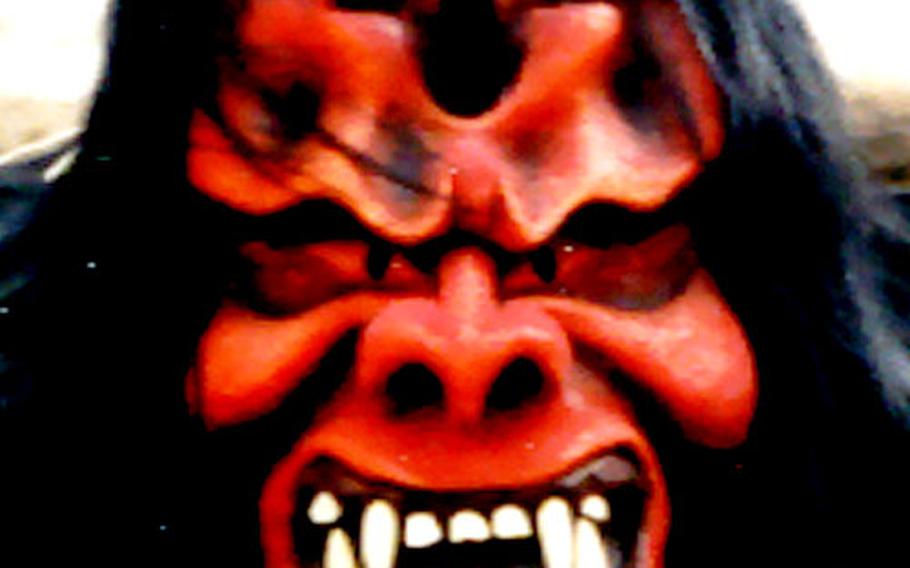
There’s plenty of interaction between scary-masked "beasts" of the Tschäggättä parade and the crowd as they try to scare or smooch with onlookers. (Leah Larkin / Special to S&S)
Wood is in her blood, Agnes Rieder says. But not just any wood. It’s pine that she has been carving for 38 years. Her husband, Ernst, has been taking a pick to wood even longer. And her children (five sons, one daughter) and grandchildren all carve, too. So did her parents.
Tucked away in in the village of Wiler, in Switzerland’s Lötschental region, the Rieders are not turning out cute figurines for tourists. They carve masks — grotesque, frightful, gruesome faces.
It’s all part of a Carnival tradition called “Tschäggätta,” the name of the costumed characters who wear the masks. The custom has been practiced for centuries in this valley, once called the end of the world because it was so hard to reach.
The Lötschental is in the southern Swiss canton of Wallis. The Lötschberg railway was built through the mountains in 1910, opening up the mysterious and romantic region of sunburned chalets and rugged peaks. Even today, for those coming from the north there are no direct roads into the valley. Visitors must put their cars on a train in Kandersteg for the trip to Goppenstein and entrance to the valley.
At her workshop, whose walls and shelves are full of the weirdly wonderful masks, Rieder chips away at a block of wood.
“I always try to make something better,” she says. “It’s hard work, but I don’t want to make the same face over and over.”
Her masks are original. If someone presents her with a photo and asks her to make a mask in its likeness, she refuses. And, she says adamantly, the masks are not pretty. She especially likes big, ugly noses.
In the old days, in the Carnival season before Ash Wednesday, the unmarried young men of the village would put their clothes on inside out, cover up their shoes with sacks, wrap themselves in a blanket of sheep or goat fur, then don a scary mask they had carved themselves. They also wore soot-covered mittens and a cowbell attached to a fat leather belt. They’d run through the villages at night, clinging and clanging, in search of victims to scare and whose faces they would smear with soot.
Then, the men had only two pairs of shoes, one for work and one for Sunday and dressy occasions. They covered their shoes and turned their clothing around lest they be recognized.
The Tschäggättä still march during Carnival season, but now even children and older men are known to wear the grisly masks, and the event has become a tourist attraction. Many wear old masks handed down from their ancestors, while others may purchase a mask from Rieder or other carvers in the area.
Rieder said that there are many theories as to how the Tschäggättä got started. In the 13th century, there was a shortage of food and robbers were thought to have disguised themselves in the frightful costumes as they pillaged houses for food.
According to another theory, it all started during a peasant revolution in 1550 when the rebels wore costumes so they would not be recognized. Yet another explanation attributes the custom to the folk theater of the 19th century with its devil figures. And, there’s the popular belief that the Tschäggätta is an ancient pagan custom to drive away the evil spirits of winter.
The masks used to be painted with blood and a green substance made from a copper extract, but not much color was used because it was important to see the grain of the wood. Rieder, who has a collection of 400 masks, says the wood she uses must dry for five years. She often uses horse hair and teeth from goats or cows in her creations.
The artist, not shy about her talent, spends about four hours carving and another four painting the average mask, yet some elaborate masks may require 40 hours. Her large masks sell for between 1,000 and 2,000 Swiss francs (about $890 to $1,785). She sells small, souvenir masks starting at 12 Swiss francs. She says the huge cowbells the Tschäggättä wear can cost as much as the masks.
To see more of the Tschäggättä, attend the parade in Wiler or visit the valley in the Carnival season when the bizarre and wicked figures wander through the valley.
At last year’s parade, marching bands of Tschäggättä as well as isolated figures paraded through the town. Most wore numbers as they are judged for their mask and costume. There were also a few non-Tschäggätta floats featuring, among others, Nemo and German chancellor Gerhard Schröder.
There’s plenty of interaction between the Tschäggättä and the crowd as the mean, furry beasts try to scare or smooch with onlookers. Fortunately, these days they don’t have soot on their mittens. It’s fun, a great photo opportunity, and you can sip a Glühwein to keep warm while watching it all.
Leah Larkin, a member of the Society of American Travel Writers, is a journalist living in France.
If you go ...
This year’s Tschäggätta parade in Wiler is on Feb. 5 at 2:30 p.m. On Feb. 3, beginning at 8 p.m., the Tschäggättä walk through the valley, starting in the town of Blatten and ending in Ferden about midnight. Then they gather in local guest houses and party most of the night.
While there are no other scheduled events, the Tschäggättä normally come out every night during Carnival (this year Feb. 3-8) and wander the streets looking for victims to frighten.
More information on the event, in German, can be found at www.loetschental.ch; e-mail questions to info@loetschental.ch.
— Leah Larkin